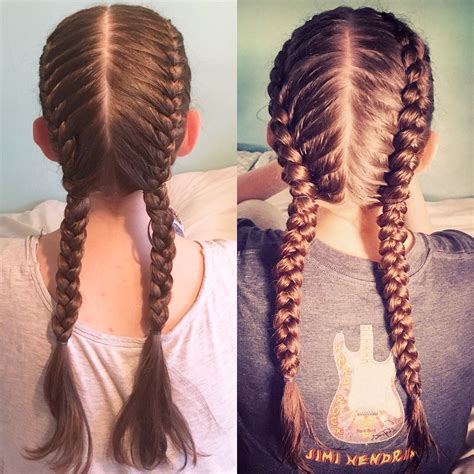When it comes to protective hairstyles, Dutch and French braids reign supreme. While both techniques create intricate plaits, there are subtle yet distinct differences that set them apart. This article delves into the world of Dutch vs French braids, providing a comprehensive comparison to guide your next hairstyling decision.

Dutch braids, also known as inside-out braids, are characterized by their underhand technique. With each braid, the strands are crossed under the middle strand, creating a raised effect. This results in a braid that appears bold and textured.
Difference 1: Crossover Technique
| Dutch Braids | French Braids | |
|---|---|---|
| Crossover | Underhand | Overhand |
Difference 2: Appearance
| Dutch Braids | French Braids | |
|---|---|---|
| Texture | Bold, raised | Smooth, flat |
French braids, also known as outside-in braids, are the epitome of classic elegance. They are created by crossing the strands over the middle strand, resulting in a braid that lies smooth and close to the scalp.
Difference 3: Crossover Technique
| Dutch Braids | French Braids | |
|---|---|---|
| Crossover | Underhand | Overhand |
Difference 4: Appearance
| Dutch Braids | French Braids | |
|---|---|---|
| Texture | Bold, raised | Smooth, flat |
- Crossover Technique: Dutch braids use an underhand crossover, while French braids use an overhand crossover.
- Appearance: Dutch braids are bold and raised, while French braids are smooth and flat.
- Complexity: Dutch braids are slightly more complex to create than French braids.
- Texture: Dutch braids create a textured look, while French braids create a more uniform texture.
- Volume: Dutch braids tend to add more volume to the hair than French braids.
- Hold: French braids tend to hold better than Dutch braids due to their tighter weave.
- Suitability: Dutch braids are suitable for bolder looks, while French braids are suitable for both casual and formal occasions.
- Dutch Crown Braid: Wrap a Dutch braid around the head like a crown.
- French Waterfall Braid: Allow strands to fall out of the braid as you go, creating a cascading effect.
- Dutch Braided Pigtails: Divide hair into two sections and braid each section in a Dutch braid.
- French Braided Bun: Gather hair into a ponytail and secure it with a bun holder, then weave a French braid over the bun.
- Dutch Side Braid: Start a Dutch braid from one side of the head and continue it down the side for a chic look.
- French Fishtail Braid: Weave two strands together to create a unique and intricate fishtail braid.
- Dutch Ladder Braid: Cross strands over and under to form a ladder-like pattern.
- French Halo Braid: Wrap a French braid around the forehead like a halo for a bohemian touch.
- Dutch Braided Updo: Combine multiple Dutch braids and pin them up to create an elegant updo.
- French Braided Headband: Braid a thin section of hair along the forehead and secure it in place as a headband.
In addition to their traditional use as hairstyles, braids can also be utilized in innovative ways:
- Braided Jewelry: Create necklaces, bracelets, and earrings using colorful braiding techniques.
- Woven Textiles: Incorporate braids into blankets, tapestries, and clothing designs for a unique texture.
- Decorative Wall Hangings: Display braided designs as wall art for a bohemian and eclectic touch.
- Braided Packaging: Use braids as closures for gift boxes and bags for a creative and sustainable wrapping option.
Table 1: Pros and Cons of Dutch Braids
| Pros | Cons |
|---|---|
| Bold, voluminous | Slightly more complex |
| Adds texture | Can be more time-consuming |
| Suitable for bolder looks | May loosen easily |
Table 2: Pros and Cons of French Braids
| Pros | Cons |
|---|---|
| Classic, elegant | Less voluminous |
| Smooth, flat finish | Tighter weave can lead to breakage |
| Suitable for all occasions | More subtle look |
Table 3: Comparison of Crossover Techniques
| Technique | Description |
|---|---|
| Underhand (Dutch) | Strands crossed under the middle strand |
| Overhand (French) | Strands crossed over the middle strand |
Table 4: Braid Complexity Levels
| Braid | Complexity Level |
|---|---|
| French Braids | Moderate |
| Dutch Braids | High |
| Fishtail Braids | High |
| Waterfall Braids | Moderate to High |
- Start with Damp Hair: Damp hair is easier to braid and holds the style better.
- Use a Styling Product: Apply a small amount of mousse or hairspray to provide hold and prevent frizz.
- Braid Tightly: Tighten the braids as you go to ensure they stay in place.
- Secure the Ends: Use hair ties or bobby pins to secure the ends of the braids.
- Finish with a Hairspray: Spray the braids lightly with hairspray to extend their longevity.
- Braiding Too Loosely: Loose braids will quickly fall apart.
- Pulling Too Tightly: Pulling too tightly can damage the hair and lead to breakage.
- Using the Wrong Products: Using products that are too heavy or greasy can weigh the braids down.
- Over-braiding: Braiding the hair too frequently or for extended periods can lead to hair damage.
- Sleeping with Braids In: Sleeping with braids in can cause friction and damage the hair cuticle.
The choice between Dutch braids and French braids ultimately depends on the desired look and hair type. Dutch braids offer a bold and textured style, while French braids provide a classic and elegant finish. By understanding the key differences, styling ideas, and effective strategies presented in this article, you can confidently create beautiful and long-lasting braids that suit your individual style.
